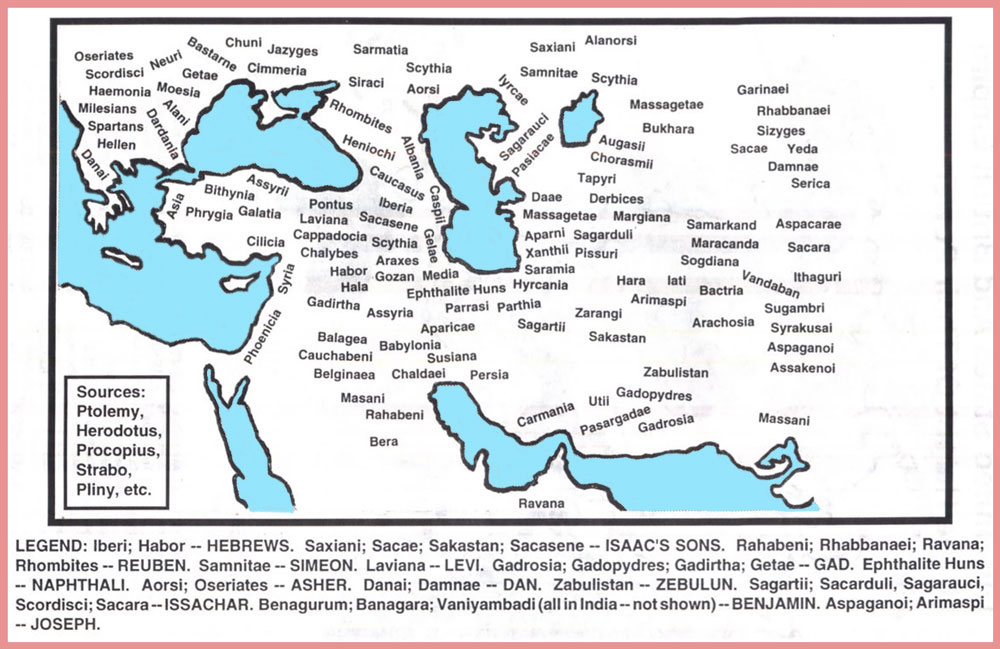
Asia's Sacae & Getae Became
Europe's Saxon & Goth
First, the GETAE and GOTH were the same people, just as " to get" and "he got" are the same verb. Spartian, who wrote about 300 A.D., said "the Goths were then called Getae" (Life of Antoninus Caracallus 10:419). Orosius 1:6 says, "the Getae, who are now also called Gothi." Procopius says, "the Goths are a Getic race." The Goths in the year 250 came from where the Getae dwelt according to Strabo, Pliny, Ptolemy and Dionysius the geographer. Ovid's Tristia and De Ponto always refer to the Moesi as Getae. Lydians and Carians were also Mysians since Herodotus says Lydus and Mysus were brothers of Caris. On the Baltic shores are found the Gotthones, Guttones, or Gythones according to Tacitus, Pliny and Ptolemy. Grotius says "on" is merely the old German plural as in Burgundi or Burgundiones; Lugi Lugiones or Gutae Guttones. They migrated to Gothland in Sweden. Ptolemy places Gutae in Scandinavia. "That the Getae were Goths cannot be doubted. The Getae were the same as the Daci." (Strabo book 7)
Second, the GETAE or GOTHS were SCYTHIANS. Procopius 4:5 says, "the other Gothic nations, who were also called Scythians in ancient times." Theophanes before 370 A.D. says, "the Scythians are in their tongue called Goths." Georgius Syncellus says, "the Scythians are also called Goths in their own language." Odin led the Goths from Scythia on the Danastrom (Dniester) to Scandinavia. The Goths came from Dacia. Pliny 4:12 says "Getae (were) called Daci by the Romans." The Goths did not originate in Scandinavia and travel to Asia as Jordanes wrote in his fourth chapter in 530 A.D. Herodotus 4:11 says the Scythians passed from the Araxes to Cimmeria. Diodorus Siculus says the Scythians spread from the Araxes to the Caucasus to the Paulus Meotis (2:155). Justin says, the Scythians contended with the Egyptians, then esteemed the earliest of nations, for antiquity; and that Asia was conquered by them, and tributary to them, for no less than fifteen hundred years, before Ninus, founder of the Assyrian Empire, put an end to the tribute. (Hist. 1:1:2:3). Dionysius the geographer, says the region between the Euxine and Caspian were all peopled by Scythae (5:798). Pontus, Armenia, Iberia and Albania were all Scythic settlements. In addition, the Bactriani and Parthians were Scythians (Justin 2:1:3). Sogdiana (Curtius 7:8; Strabo), Dahae (Pliny 4:17; Steph. Byz.), the Alani, Massagetae, Hyrcani and Margiani were all Scythians. Thucydides 2:21 says the Scythians were first among the nations in valour and wisdom. Herodotus 4:46 says the Scythians were learned and wise.
Third, the SCYTHIANS were SACAE or SAXONS. Sharon Turner wrote, "of the various SCYTHIAN nations which have been recorded, the SAKAI, or SACAE, are the people from whom the descent of the SAXONS may be inferred, with the least violation of probability.... Ptolemy mentions a SCYTHIAN people sprung from the SAKAI, by the name of SAXONES." The SAKAI, the MASSAGETAI, and the ARIMASPOI came originally from the SCYTHIANS. (Dio. Sic. p.127). Albinus (1st century B.C.) wrote, "The SAXONS were descended from the ancient SACAE in Asia, and in process of time they came to be called SAXONS."